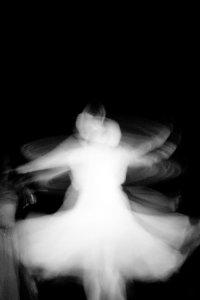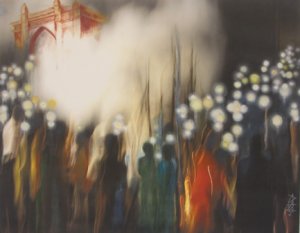
|   |

|   |
The Quest - Padma Jayaraj e-mail: padmajayaraj@gmail.com Pics: Courtesy the artists March 18, 2013 It was a fascinating evening when I stumbled upon the trajectory that Fine Art Photography is orchestrating itself as a new genre. In the odyssey of world art, photography is humanity’s youngest art form. Throughout its history photography has been in a flux. In its complex existence, it has been identified with multifaceted ideas: conceptual, historical, political, cultural, and social, apart from being a visual practice. Fine art photography, at the conceptual level, is motivated by aesthetic concerns. In practice, it undergoes continual revelations. It is accepted as creative art and is admired for its imaginative, intuitive, aesthetic and intellectual contents. An artist propelled by his/her intuitive vision, manipulating technology and engineering light, captures an image to reveal hidden dimensions, is what fine art photography is at the simplest. It defies definitions, because of its wide range of applications. It opens the shutters of a viewer’s vision to arrive at the flash of illumination. The symbiotic relationship between the artist and the viewer unfolds a dramatic moment from the ever flowing narrative of Time- a moment alive in split seconds, in many dimensions, enticing the sensory, mental, emotional, and spiritual perceptions of a sensitive viewer. A photographic exhibition ‘Impermanence’ in Mumbai’s Jehangir Art Gallery (March 7 to 13) by Anita Anand displayed her collection curated to highlight the Buddhist theme of impermanence. Winner of much recognition, Anita is a multitalented personality. Here, a digital camera is her magic wand. A few photographs among the collection transcended the outer reality to focus on a different realm. Poetic in theme the pictures reveal unseen facets that go beyond the transient.  Flight I stand in front of a picture that shows a flying bird. It captures the momentum of the flying bird, rather than its shape. The photograph suggests the bird in its joyous haven, perhaps singing and soaring. It suggests the migration of birds, the unchartered course, destinations unknown, the sight that has baffled mankind down the centuries. For me, memories replay a rockyscape where a river meets the sea, where the cranes used to alight for days on end on their way from their wintry home; a skyscape where they sing their vespers to the glory of sunsets. Yes, Art is evocative.  Dervish I am mesmerised before A Dancer. The form dissolves into the dance...just the whirling, a scintillating performance! “It reminds me of a sufi saint dancing in ecstasy,” I murmured more to myself. “It is the photograph of a sufi dance,” said Anita, the artist. That was the point where we met. And we met across oceans, the artist who had clicked the picture and the artist submerged within me who has failed to explore the soul of a visual experience. In fact, I have not seen a sufi dancing, save in a drama that a theatre group from Pakistan brought to an international show. Here, my experience validated something deep within, something I could not fathom. Maybe, the mystery of Art! Beauty without colour has an otherworldly charm. Against shades of black in folds of feathery white, her art belongs to a different landscape. Phoenix-like, the forms and figures rise from the harmony of fluid reality. Anita’s foray is a quest for art in realism. Fine Art Photography, as the very name suggests, presents not a picture, but a painting, not a piece of treated paper but an evocative photograph. As an unforeseen sequel to Anita’s pictures, the following day, I came across ‘Photo-Genius Art,’ the fourth one in a series by Ashok Roy in Nehru Centre Art Gallery. “It is a magical process,” says the artist. He converts a photograph into an abstract painting. The form of a picture, though hidden, remains central to his painting. “I get the photograph enhanced and printed on to the canvass. Then I apply brush strokes in oil to transform the photograph into a painting.” Inspiration leads him until the composition emerges in a form on its own: right from realistic, to figurative, and to semi or even pure abstract. His ‘smoke series’ recalls Anita’s photographs. They show the next inevitable step that the course of art will take from Fine Art Photography, although the use of colours makes them different. Smoke emanating from a lighted incense stick is captured in a photo and is transformed into “Aum” on the canvass. Most of the smoke series have a religious aura. 



‘Peace March’ based on an abstract photography depicts the candle lit rally of citizens at the India Gate, which has contemporary, social and political overtones besides its aesthetic appeal. The ‘flame series’ is another innovative attempt to transform a photograph of flickering flames into dynamic human forms. ‘Water series’ are stunning; here we are treated with God’s own creation, the veil is lifted for the moment, water splashes in its molecular form! There are beautiful compositions like the picture of a burst of blazing gold shower in the dark sky from a firecracker tilted to a different perspective. Lo...a new beauty is born.... I wish he has not named it. The artist, for reasons important to him has the habit of naming his paintings. At times, it is better to leave without a specific name that limits a work of art. Ashok Roy, as a painter belonged to the world of advertisement. His autumnal days are cast for a new genre. Do we hear footfalls to follow footprints? Both the artists are Mumbai based to attract followers, for even in this globalised world people like to meet people during their quest, to share, to inspire each other and perhaps to follow. Padma Jayaraj is a freelance writer on the arts and travel. She is a regular contributor to www.narthaki.com |